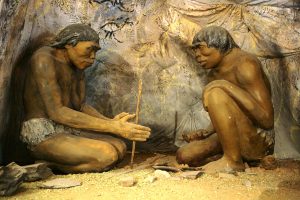 Yes, the paleo diet does tell you to eat like cavemen, but if you’re eating in Raleigh, NC capturing your prey and foraging the woods for berries and greens isn’t a lifestyle everyone can follow. However, the concept of eating similar foods to that of a caveman is a far healthier idea than the average American’s diet today. Cavemen didn’t farm, an agrarian society didn’t exist at that time. It’s doubtful they had milk products, although no one is sure whether these nomads first used antelopes for milk.
Yes, the paleo diet does tell you to eat like cavemen, but if you’re eating in Raleigh, NC capturing your prey and foraging the woods for berries and greens isn’t a lifestyle everyone can follow. However, the concept of eating similar foods to that of a caveman is a far healthier idea than the average American’s diet today. Cavemen didn’t farm, an agrarian society didn’t exist at that time. It’s doubtful they had milk products, although no one is sure whether these nomads first used antelopes for milk.
Eating like a caveman means eating cleaner, but it also means avoiding dairy, legumes, beans and grain.
While modern agriculture has changed the color, texture, size and taste of many of the vegetables that may have existed as far back as 780,000 years ago, many did exist in forms that we might not recognize. Carrots weren’t orange and kale, cauliflower, cabbage, broccoli, Brussels sprouts, and kohlrabi all started as one vegetable, then farmers bred that one leafy plant to create the characteristic veggies we know today. There were no grains harvested and beans might have been eaten, had caveman known how to prepare them.
Eating beans and legumes are avoided for other reasons.
One big discrepancy in the paleo diet is that they say that beans and legumes are to be avoided because of the phytic acid. Phytic acid blocks the absorption of iron, zinc and some calcium. However, nuts also contain phytic acid and they’re included. That’s one of the problems people have with a paleo diet. While phytic acid blocks the absorption of some nutrients, it only blocks the absorption in that particular food, not all foods. The oxylic acid in spinach does the same with calcium, yet spinach is on the power food list.
There are great reasons to eat like a caveman.
Cavemen didn’t have additives in their food. There were no pesticides. There were few types of foods that provided sweetness, fruit was one of those and honey another. The food was clean, much of it eaten raw, except for meat. Meat came from grass fed animals, which is far more nutritious and heart healthy than those raised on grain. Eggs were consumed, so was whatever food that was available. Eating to the caveman was a matter of survival, rather than selecting foods for health. Cavemen ate a wider variety of foods than we do today, based on their location. However, today, we’d do better to eat more whole foods, like the caveman did and less processed and refined foods.
- There are petroglyphs in caves showing early man harvesting honey. In fact, it’s believed that honey may have had an important role in the human brain evolving.
- Cavemen didn’t eat a lot at one time. Part of the reason is they ate what they found, on the spot in many instances. Another part may have been to avoid poisoning if they didn’t recognize the food.
- Cavemen could teach us a thing or two about exercise. They had to search for food and that meant a lot of walking.
- Cavemen didn’t waste many parts of an animal. They ate organ meat and may have even made soup, according to one archeological study. Bone broth is still a good addition to a paleo diet.
